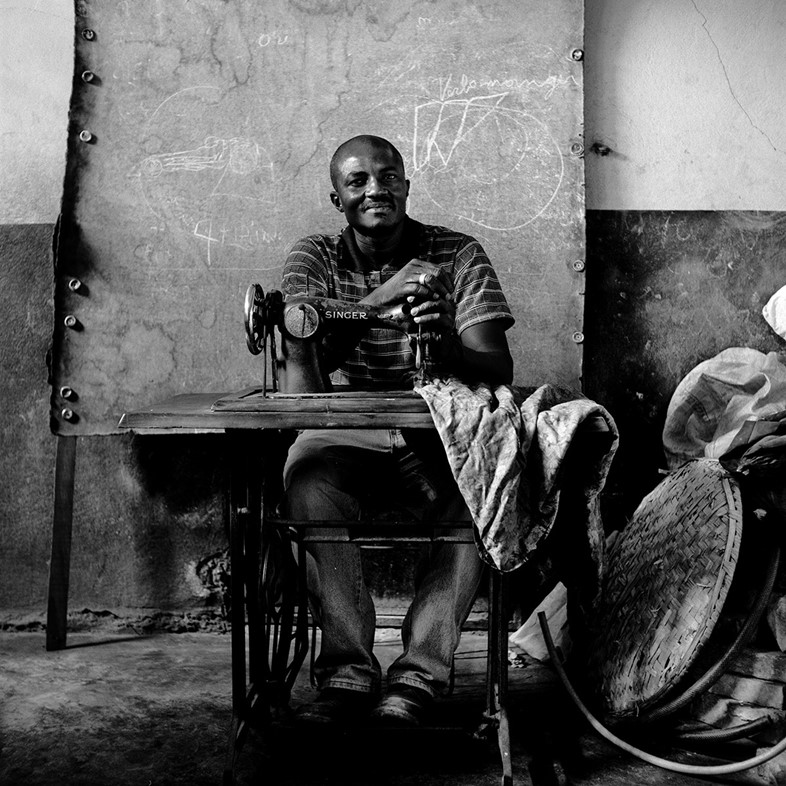In Haiti, fast fashion meets its end game with pèpè, an accidental style made from cast-off clothing from the west – but what does it reveal about our addiction to disposable garms?
“We Haitians, despite the misery, love beauty, love to get dressed up, to smell and look good,” says fashion designer David André. “So many people tend to believe that fashion doesn’t affect a society. They are so wrong. Human beings always seek change. They yearn for new tastes and new styles, and this desire is adequately fulfilled by fashion.”
André’s comments reflect my own experiences travelling in Haiti over the last few years, researching a book about the country’s music scene. I remember churchgoers in their Sunday best and streets full of schoolkids in pin-sharp navy uniforms, proud Mardi Gras Indians in headdresses hung with tinsel, and Vodou worshippers in paper-white dresses and head-scarves gleaming in the early morning light. In my sweat-stained t-shirts and jeans thick with road dust, I always felt like a terrible scruff. Once I even got heckled at a bus station: “Look at the state of you, mon chè. Your clothes are filthy!” Rad pa janm fè moun (clothes do not make a person), or so the Haitian proverb goes, but I guess they’re somewhere to start.

Day to day in Haiti, a lot of what people are wearing is pèpè – secondhand clothing, the majority of it from charity shops and collection centre in North America, which arrives at Haitian ports plastic-wrapped in giant bails. It’s sold on street markets from the frenetic capital Port-au-Prince to the remote villages of Grand’Anse in the west. Machann (traders) sit fanning themselves under beach umbrellas sorting through mounds of coloured fabric, dried by the Caribbean sun.
Imports of pèpè began under the Kennedy administration in the 1960s (they’re sometimes referred to as ‘Kennedy clothes’). Since then, thousands of tonnes of unwanted clothing have found their way to Haiti. With the rise of fast fashion, the flow has increased exponentially, flooding the Haitian market. For many locals, pèpè is a godsend. In recent years the cost of living has spiralled. Civil unrest, some of it fallout from the assassination of President Jovenel Moïse in 2021, and an explosion in gang violence have made life even more precarious. “I wear a lot of pèpè,” says Gilles, a musician from the town of Léogâne. “We all do, because it’s a lot less expensive than buying new things.” Pèpè also gives Haitians access to brands they’ve heard about online, Gilles says, reeling off a list of labels he looks out for: “Nike, Adidas, Reebok, Lacoste. People here love it.”
But pèpè is both a blessing and a curse. As photographer Paolo Woods observed in his Pèpè series, it can exemplify many of the cruellest and most condescending aspects of the global fashion industry. Bundled in with the good-quality garments you also find the dregs – “the worst t-shirts, those that would barely be sold in the cheap gift shops of Times Square, those with the dumbest slogans”, writes Woods on his website – which end up being worn by Haitians who are often unaware of their meaning. Sometimes this can be surreal and vaguely humorous, like the time I passed an elderly woman in the mountains near Seguin wearing a t-shirt that read, “It’s not you, it’s your eyebrows”. Mostly, though, it feels like an affront to the wearer’s dignity, particularly when the slogan is lewd or bitterly ironic (“I Pee In Pools” and “Winning A Million Dollars Won’t Change Me” are just two examples in Woods’ series). In this sense, pèpè is just another way in which the neocolonialist global economy kicks people when they’re down – particularly when you consider that some of these t-shirts will originally have been produced in Haitian sweatshops.
“So many people tend to believe that fashion doesn’t affect a society. They are so wrong. Human beings always seek change. They yearn for new tastes and new styles, and this desire is adequately fulfilled by fashion.” – David André, Haitian fashion designer
Just as imports of cheap rice and other staple foods have damaged Haitian agriculture, pèpè has had a disastrous effect on the country’s fashion industry, putting hundreds of tailors out of business. There has been talk of banning pèpè imports in the past, but powerful figures in Haitian society make big money out of it, so legislation seems unlikely.
André is a vocal critic of pèpè. He remembers how different things were when he was growing up in the 80s. “My dad used to take my brother and me to the tailor’s workshop in Port-au-Prince to have our school uniforms made, suits for special occasions, formal Sunday attire to go to church, and I remember his atelier used to be full of work. Back in the day each family in Haiti had their seamstress and tailor to create the latest fashion. We used to have lots of tailors, seamstresses, shoemakers and embroiderers who worked for export, factories that made shoes for local and international brands, fancy boutiques that sold clothes made in Haiti…” Now, all that has changed. “It’s complicated to have a fashion industry in Haiti where, for a big percentage of the population, it’s a daily struggle to eat, or find water to drink,” says André. “[With] political instability, the fact that we have stopped producing locally, and the cost of living [which] has increased so much so many people have no choice but to turn to pèpè.”
With his own work, André is fighting back. In spite of the challenges, he produces all of his fashion lines in Haiti, employing local workers. He has a deep love for Kreyòl tradition: the puffed sleeves and skirts decorated with lace, the famous headscarf (the maré tèt), an indigo fabric known as karabela blue and chambray cotton, used to make costumes for dances and Vodou ceremonies. “A few years ago I created some pieces in karabela called Choucoune, that paid tribute to the elegance and beauty of the Haitian woman,” says André. “When I create costumes for a Haitian folkloric dance performance, inevitably I have to go back to the source, the roots, in order to be inspired and let the magic of creativity shine.”
“With political instability, the fact that we have stopped producing locally, and the cost of living which has increased so much so many people have no choice but to turn to pèpè.” – David André
That same magic might be the key to rethinking pèpè. One of the many inspiring things about Haiti is the culture of upcycling. You only need to look at the tricked-out tap taps (trucks) and hand-me-down American school buses rattling through the streets of Port-au-Prince to see what I mean. Some of them are like trundling art exhibits, with peacock-fans of decorative wing mirrors, luggage racks shaped like aeroplanes and custom paint jobs jostling with saints and celebrities. You have collectives like the artisans of Noailles, who turn discarded oil drums into decorative metalwork, and the sculptors of Atis Rezistans, who make art from splintered wood, rusting car parts and even a few bones.
“The best thing for me is the creativity inside recycling,” says André Eugène, a sculptor and founding member of Atis Rezistans. “You can find something good in the street, someone puts something in the garbage, and you can use it to create whatever you want, whatever’s in your mind.” The same goes forclothing. David André has noticed a trend for skinny jeans among fashion-conscious young Haitians who buy baggy pèpè jeans and modify them – a reminder that clothes can be a source of escapism, fun, self-care and self-respect.

La Baze featured in Leah Gordon’s series about the surviving tailors of Port-au-Prince (there’s a beautiful portrait of him sitting at his turn-of-the-century Singer sewing machine). He also worked with Gordon on her project exploring caste in Haiti, making detailed historical costumes for her models, including richly embroidered robes and a Phrygian cap worn by Eugène. Like most Haitian tailors, he finds the majority of his work making school uniforms, one of the few garments still produced locally. But he continues to reimagine pèpè, creating artistic pieces to sell overseas when he can. He enjoys the process of transformation – of turning something old into something new.
“It’s hard to be an artist in a developing country,” says La Baze over the phone. “There are lots of difficulties. Nowadays people don’t appreciate artistic clothing, and even if they do they can’t afford it. But it’s an artform I love. Since the day we were put on the Earth we’ve made clothes – from the leaves of trees, from animal skins. It’s the earliest craft that we have.”
In a world in which vast quantities of clothing end up in landfill, pèpè presents an opportunity. Recycling fabric from pèpè or transforming it into high-value garments for the international market could be a boon to the Haitian economy, but to unlock its potential, the country needs change.
La Baze looks back fondly on the Made in Haiti project. “We worked a lot! But it didn’t last,” he says. “In Haiti, projects like that are handicapped. The truth is, things aren’t working here. Tourists can’t come. There’s no work, no money. Art is sleeping.” He hopes there will be more collaborations in the future. “That’s the thing about fashion: you can’t do it alone.”




























![Phyllisia Ross – KONSA [Official Music Video]](https://haitiville.com/wp-content/uploads/2014/08/phyliisia.jpg)









